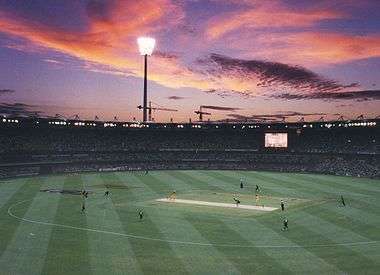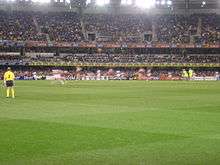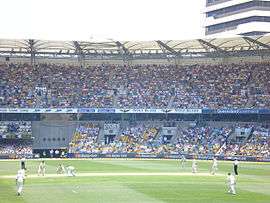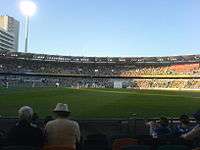The Gabba
|
| |||||||||||||
 | |||||||||||||
| Ground information | |||||||||||||
|---|---|---|---|---|---|---|---|---|---|---|---|---|---|
| Location | Woolloongabba, Queensland, Australia | ||||||||||||
| Coordinates | 27°29′9″S 153°2′17″E / 27.48583°S 153.03806°ECoordinates: 27°29′9″S 153°2′17″E / 27.48583°S 153.03806°E | ||||||||||||
| Establishment | 1895 | ||||||||||||
| Capacity | 42,000 (36,000 for international cricket matches) | ||||||||||||
| Owner | Queensland Government | ||||||||||||
| Operator | Stadiums Queensland | ||||||||||||
| Tenants | Queensland cricket team, Brisbane Lions, Brisbane Heat | ||||||||||||
| End names | |||||||||||||
|
Stanley Street End Vulture Street End | |||||||||||||
| International information | |||||||||||||
| First Test |
27 November – 3 December 1931: | ||||||||||||
| Last Test |
23–27 November 2017: | ||||||||||||
| First ODI |
23 December 1979: | ||||||||||||
| Last ODI |
19 January 2018: | ||||||||||||
| First T20I |
9 January 2006: | ||||||||||||
| Last T20I |
13 February 2013: | ||||||||||||
| Team information | |||||||||||||
| |||||||||||||
|
As of 14 December 2017 Source: ESPN Cricinfo | |||||||||||||
The Brisbane Cricket Ground, commonly known as the Gabba,[1][2] is a major sports stadium in Brisbane, the capital of Queensland, Australia. The nickname Gabba derives from the suburb of Woolloongabba, in which it is located.
The land on which the ground sits was set aside for use as a cricket ground in 1895 and the first match was held on the site on 19 December 1896, between Parliament and The Press. Prior to this, cricket was played at a ground in the area then known as Green Hills (beside Countess Street Petrie Terrace opposite the Victoria Barracks – now occupied by the Northern Busway),[3] since at least the early 1860s.[4]
The Gabba shared first-class cricket matches with the Exhibition Ground until 1931. The first Sheffield Shield match at the Gabba was scheduled to be played between 31 January 1931 and 4 February 1931, but it was washed out without a ball being bowled. The first Test match at the Gabba was played between Australia and South Africa between 27 November and 3 December 1931.
Over the years, the Gabba has hosted athletics, Australian rules football, baseball, concerts, cricket, cycling, rugby league, rugby union, soccer and pony and greyhound races.
Between 1993 and 2005, the Gabba was redeveloped in six stages at a cost of A$128,000,000. The dimensions of the playing field are now 170.6 metres (east-west) by 149.9 metres (north-south) to accommodate the playing of Australian Football at elite level. The seating capacity of the ground is now 42,000; however, for international cricket matches, the seating capacity is reduced to around 36,000 due to new bigger screens and the addition of a pool deck, as well as wider sight screens.[5]
On 15 December 2016, Australia hosted Pakistan for the first day-night Test at the Gabba,[6] and the first Australian day-night Test hosted outside Adelaide Oval.
Sports played at the ground
Cricket

The First Test between Australia and England is played nowadays at Brisbane. Nobody seems to know why, and all sorts of arguments are ventilated for and against more cricket Tests on the Woolloongabba ground. I am all in favour of robbing Queensland of its greatest cricketing occasion, for the ground depresses. It is not a cricket ground at all. It is a concentration camp! Wire fences abound. Spectators are herded and sorted out into lots as though for all the world this was a slave market and not a game of cricket. The stands are of wood and filthy to sit on. The dining rooms are barns, without a touch of colour or a picture on the wall. Everywhere there is dust and dirt...Forgive me if I am bitter about the Woolloongabba ground...the city has many good points, and the people who live there are generous and hospitable to the highest degree, but once one goes to the cricket ground the advantages are overwhelmingly lost in the mass of rules and regulations...[7] – John Kay, 1950–51 Ashes series
The Gabba is used from October to March for cricket and is home to the Queensland Cricket Association, the Queensland Cricketers Club and the Queensland Bulls cricket team. The venue usually hosts the first Test match of the season each November in addition to a number of international one-day matches usually held in January. The pitch is usually fast and bouncy.
The Gabba's amenities were greatly improved in the 1980s from a very basic standard, especially in comparison with the other Australian cricket grounds. Test cricket was first played at the ground in November 1931, the first Test of the series between Australia and South Africa. In December 1960, Test cricket's first-ever Tied Test took place at the ground when Richie Benaud's Australian team tied with Frank Worrell's West Indian side. Queensland clinched its first-ever Sheffield Shield title with victory over South Australia in the final at the ground in March 1995.
The Gabba was the first Australian venue to host an International Twenty20 cricket match.[8]
In November 1968 Colin Milburn scored 243 – in the two-hour afternoon session he scored 181- in a Sheffield Shield match for Western Australia vs. Queensland [9]
For the first day of the first Test of the 2010–11 Ashes series between Australia and England the Gabba was almost sold out.[10] Australia's Michael Clarke holds the record for number of runs scored in one Test innings at the Gabba with 259 not out, breaking the previous record set by Alastair Cook.[11]
Australia has a formidable test match record at the ground. In the 55 matches played at the ground, Australia has won 33, drawn 13, tied 1 and lost 8. Australia has also not lost at the Gabba in 28 matches, a record dating back to 1988.[12] England have a notoriously poor record at The Gabba, and have only won two test matches at the ground since the end of the Second World War. Many of their defeats have been heavy[13] and only seven England players have scored centuries at the ground.
Australian rules football


The Gabba was the home ground for the Brisbane Bears from 1993 to 1996 and since 1997 has been the home of the Brisbane Lions AFL team. The record crowd for an Australian rules football match is 37,224 between the Brisbane Lions and Collingwood in Round 15 of the 2005 AFL season.
Australian football has a long association with the ground. The Queensland Football League, a precursor to AFL Queensland played matches at the Gabba from 1905 to 1914, 1959 to 1971, and in the late 1970s and early 1980s. AFLQ matches resumed in 1993 as curtain-raiser events to AFL games, along with occasional AFLQ Grand Finals.
Interstate games, including the 1961 national carnival have also been played there, as was a demonstration game during the 1982 Commonwealth Games. In 1991 the Gabba was host to Queensland's only victory over a Victorian side.
Soccer
In the early 1900s, the Gabba hosted numerous matches between Australia and various touring nations.[14] During the 1950s and 1960s the Gabba hosted soccer matches for English first division and Scottish clubs including Blackpool FC, Everton FC, Manchester United and Heart of Midlothian.[15] The Chinese and South African national teams also played at the ground. During the 2000 Summer Olympics, the Gabba hosted association football group games.[16]
Rugby league
On 8 May 1909 the first match of rugby league was played in Brisbane at the Gabba. Norths played against Souths before a handful of spectators at the ground.[17] The Gabba hosted its first rugby league Test match on 26 June 1909, when Australia defeated New Zealand Māori 16–13.[18] The Kangaroos continued to play Tests at this venue until 1956, and a ground record crowd of 47,800 people saw Australia play Great Britain in 1954. From 1932 to 1959 the Gabba was also used to host interstate matches and International Rugby League Finals from 1909 – 2003.
Rugby league Test matches
The Gabba hosted 11 rugby league test matches between 1912 and 1956.[19]
| Date | Opponents | Result | Attendance | Part of |
|---|---|---|---|---|
| 14 August 1909 | 16–13 | 8,000 | 1909 Māori tour | |
| 6 July 1912 | 13–10 | 8,000 | 1912 Trans-Tasman Test series | |
| 18 June 1932 | 15–6 | 15,944 | 1932 Ashes series | |
| 4 July 1936 | 7–12 | 29,486 | 1936 Ashes series | |
| 12 June 1948 | 13–4 | 23,014 | 1948 Trans-Tasman Test series | |
| 1 July 1950 | 15–3 | 35,000 | 1950 Ashes series | |
| 30 June 1951 | 23–11 | 35,000 | ||
| 28 June 1952 | 29–45 | 29,243 | 1952 Trans-Tasman Test series | |
| 9 July 1954 | 21–38 | 46,355 | 1954 Ashes series All time Gabba attendance record | |
| 2 July 1955 | 28–29 | 45,745 | ||
| 23 June 1956 | 8–2 | 28,361 | 1956 Trans-Tasman Test series |
Rugby union
The Gabba has hosted six rugby union Test matches.
| Year | Home team | Away team | Result | Score | Crowd |
|---|---|---|---|---|---|
| 1907 | Lost | 14–5 | not known | ||
| 1914 | Lost | 17–0 | not known | ||
| 1950 | British and Irish Lions | Lost | 19–6 | not known | |
| 1951 | Lost | 16–6 | not known | ||
| 2001 | British and Irish Lions | Lost | 29–13 | 37,460 | |
| 2002 | Won | 38–27 | 37,258 |
2000 Olympic Games
The Gabba hosted seven games of the 2000 Olympic Games Men's Football tournament including a Quarter final match.
| Date | Time (AEST) | Team #1 | Result | Team #2 | Round | Attendance |
|---|---|---|---|---|---|---|
| 13 September 2000 | 19:00 | 3–2 | Group C | 26,730 | ||
| 14 September 2000 | 19:00 | 3–1 | Group D | 24,616 | ||
| 16 September 2000 | 19:00 | 2–3 | Group C | 22,182 | ||
| 17 September 2000 | 19:00 | 1–3 | Group D | 36,326 | ||
| 19 September 2000 | 19:00 | 1–1 | Group C | 23,442 | ||
| 20 September 2000 | 19:00 | 1–0 | Group D | 36,608 | ||
| 23 September 2000 | 19:00 | 1–2 (a.e.t.) | Quarter final 2 | 37,332 |
Greyhound racing
Greyhound racing was also conducted at the Gabba prior to the redevelopment.[20]
Awards
In 2009 as part of the Q150 celebrations, the Gabba was announced as one of the Q150 Icons of Queensland for its role as a "structure and engineering feat".[21]
Largest crowds at the Gabba
- Concerts – 65,000 – Adele Live 2017, 4/5 March 2017
- Rugby League – 46,355 – Ashes Test Match: Australia v Great Britain, 9 July 1954
- International Cricket – 38,874 – 2006 VB Series T20I: Australia v South Africa, 15 January 2006
- Rugby Union – 37,460 – 2001 British and Irish Lions tour to Australia British and Irish Lions vs Australia, 30 June 2001
- Association Football – 37,332 – 2000 Olympic Football (Men's) Brazil v Cameroon, 23 September 2000
- Australian Football – 37,224 – 2005 AFL Season Brisbane Lions v Collingwood, 9 July 2005
- Domestic Cricket (Big Bash League) – 35,564 – 2017–18 BBL Season: Brisbane Heat vs Perth Scorchers, 5 January 2018
VFL/AFL records
Players
- Most games played: Simon Black (Brisbane Lions), 170
- Most goals kicked: Jonathan Brown (Brisbane Lions), 323
- Most goals kicked in a match: Billy Brownless (Geelong), 11.4 (70) vs. Brisbane Bears, 14 April 1991
- Most disposals in a match: Tom Rockliff (Brisbane Lions), 47 vs. Gold Coast, 26 July 2014
Teams
- Highest score: Brisbane Bears 33.21 (219) defeated Sydney 8.9 (57), 16 May 1993
- Lowest score: Brisbane Bears 5.8 (38) defeated by Carlton 9.8 (62), 15 June 1996, Brisbane Lions 5.8 (38) defeated by North Melbourne 16.14 (110), 25 July 2015
- Biggest margin: Brisbane Bears defeated Sydney, 162 points, 16 May 1993
- Longest winning streak: Brisbane Lions, 18 games, 2001–2002
Last updated: 19 May 2015.[22]
Gallery
 Test match between Australia and South Africa at the Gabba in Nov 2012
Test match between Australia and South Africa at the Gabba in Nov 2012- The Gabba prior to redevelopment
 Shane Warne in action at the Gabba
Shane Warne in action at the Gabba The Gabba in 2006–07 Ashes series
The Gabba in 2006–07 Ashes series
See also
References
- ↑ "Gabba (Brisbane Cricket Ground) - Austadiums". www.austadiums.com. Archived from the original on 17 June 2017. Retrieved 21 March 2018.
- ↑ "Brisbane Cricket Ground - Australia - Cricket Grounds - ESPNcricinfo". Cricinfo. Archived from the original on 23 February 2018. Retrieved 21 March 2018.
- ↑ "Pictorial Brisbane 1860 – 1875". Brisbanehistory.com. Archived from the original on 27 June 2012. Retrieved 19 July 2012.
- ↑ "The Home of CricketArchive". cricketarchive.com. Archived from the original on 1 December 2017. Retrieved 21 March 2018.
- ↑ Meyn, Travis. "Ashes Extras: Brisbane Heat batsman Chris Lynn enjoys first Test from the Gabba pool deck". news.com.au. Archived from the original on 26 December 2017. Retrieved 26 December 2017.
- ↑ "Australia v Pakistan: Steve Smith century puts hosts in charge in day-night Test; Matt Renshaw, Peter Handscomb shine". Australian Broadcasting Corporation. Archived from the original on 15 December 2016. Retrieved 15 December 2016.
- ↑ pp59-60, John Kay, Ashes to Hassett, John Sherratt & Son, 1951
- ↑ Match Records Archived 30 September 2012 at the Wayback Machine. Cricinfo
- ↑ "Colin Milburn – An Indomitable Spirit | Cricket Features | Wisden Cricket Monthly". ESPN Cricinfo. Archived from the original on 11 November 2012. Retrieved 19 July 2012.
- ↑ Ashes tickets selling fast Archived 21 July 2011 at the Wayback Machine. ESPN
- ↑ "Ashes: England break records in draw with Australia". BBC Sport. 29 November 2010. Archived from the original on 16 December 2010. Retrieved 29 November 2010.
- ↑ "Archived copy". Archived from the original on 13 November 2012. Retrieved 20 November 2012. Cricinfo
- ↑ "Cricket Records | Records | / | Brisbane Cricket Ground, Woolloongabba, Brisbane - England | Test matches | Match results | ESPN Cricinfo". Cricinfo. Retrieved 20 November 2017.
- ↑ Behrent, Sue (2011). History of the Socceroos. Camberwell, Vic.: Penguin Books. ISBN 9780670074266.
- ↑ "Archived copy". Archived from the original on 23 May 2015. Retrieved 23 May 2015. Newspaper report
- ↑ 2000 Summer Olympics official report. Archived 9 November 2000 at the Wayback Machine. Volume 1. p. 392.
- ↑ Pramberg, Bernie (2 May 2009). "Leo Donovan special guest at BRL celebrations". The Courier-Mail. Australia: Queensland Newspapers. Archived from the original on 6 February 2012. Retrieved 29 April 2010.
- ↑ Ferguson, Shawn Dollin and Andrew. "Maori Tour 1909 Series - Game 7 - Rugby League Project". www.rugbyleagueproject.org. Archived from the original on 30 August 2017. Retrieved 21 March 2018.
- ↑ Ferguson, Shawn Dollin and Andrew. "Brisbane Cricket Ground - Results - Rugby League Project". www.rugbyleagueproject.org. Archived from the original on 21 March 2018. Retrieved 21 March 2018.
- ↑ "The history of the Gabba Greyhound Racing Club". Just Racing. Archived from the original (Web article) on 18 July 2008.
- ↑ Bligh, Anna (10 June 2009). "PREMIER UNVEILS QUEENSLAND'S 150 ICONS". Queensland Government. Archived from the original on 24 May 2017. Retrieved 24 May 2017.
- ↑ "AFL Tables - Gabba". afltables.com. Archived from the original on 18 July 2014. Retrieved 21 March 2018.
External links
| Wikimedia Commons has media related to Brisbane Cricket Ground. |
- Official website

- Brisbane Cricket Ground – Queensland Government Legislation Act, 1993 (.pdf file)
- Brisbane Cricket Ground – Statistical Overview (Test Cricket) – HowSTAT! Grounds Statistics
- "Brisbane Cricket Ground Redevelopment, Brisbane, QLD". Archived from the original on 20 September 2006.
- The Gabba at Austadiums
- "Woolloongabba Busway Station map – includes showing some of the surrounding area" (PDF). Archived from the original (PDF) on 21 September 2006.
- Satellite photo of the Gabba
- Brisbane Lions
- World Stadiums

